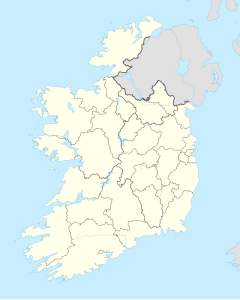Doonagore Castle
This article needs additional citations for verification. (January 2014) |
| Doonagore Castle | |
|---|---|
 Doonagore Castle, overlooking Doolin and the Atlantic Ocean | |
| General information | |
| Location | Doolin, County Clare, Ireland |
| Coordinates | 53°00′12″N 9°23′14″W / 53.00327°N 9.38713°W |
| Completed | 16th century |
Doonagore Castle is a round 16th-century tower house with a small walled enclosure located about 1 km south of the coastal village of Doolin in County Clare, Ireland. Its name may be derived from Dún na Gabhair, meaning "the fort of the rounded hills" or the "fort of the goats". Doonagore Castle is at present a private holiday home, inaccessible to the public.
Doonagore Castle sits on a hill overlooking Doolin Point and, along with a nearby higher radio mast, is used as a navigational point by boats approaching Doolin Pier. It is located in the townland of Doonagore, parish of Killilagh, County Clare. It is sometimes considered to be located in the area known as the Burren.[1]:99
History
[edit]A castle was built on (or near) the site of an even earlier ringfort by Tadhg (Teigue) MacTurlough MacCon O'Connor some time during the 14th century.[1]: 99
The current structure likely dates from the mid-16th century. Unlike most tower houses in the region, this was built not from limestone but from sandstone drawn from the quarry of Trá Leachain (Flaggy Beach) about 2 km to the southwest.[1]: 99
In 1570, it was owned by Sir Donald (or Donnell) O'Brien of the O'Brien dynasty and in 1582 it was occupied by Brian MacCahill O'Connor. In 1583, much of the property in the area was surrendered to the Crown and regranted to Turlough O'Brien of Ennistymon. Doonagore soon fell to the MacClancy (or Clancy) family, the hereditary brehons or lawyers of the O'Briens.[2][1]: 101
In September 1588, a ship of the Spanish Armada was wrecked below the castle. One-hundred-seventy survivors were caught by the High Sheriff of Clare, Boetius Clancy and hanged at Doonagore Castle[2] or on a nearby Iron Age barrow near Doolin called Cnocán an Crochaire (Hangman's Hill).[1]: 103

After the 1641 rebellion Doonagore was granted to John Sarsfield in the Cromwellian settlement.[1]: 101
In the late 17th or early 18th century, the castle came into the possession of the Gore family, resulting in the false etymology of "Gore's Castle". They repaired the castle in the early 19th century, but by 1837 it had once again fallen into a state of disrepair.[1]: 101
It was restored in the 1970s by architect Percy Le Clerc for a private purchaser, an Irish-American named John C. Gorman[2] whose family still owns it.
Description
[edit]Doonagore is one of only three cylindrical tower houses in the Burren region, the others being Newtown Castle and Faunarooska near Fanore. Mostly built from sandstone, some of its decorative features are carved from limestone. The tower house originally had four floors plus cellar with a beehive vault between the first and second floors. The doorway was protected by a machicolation connected to the wall walk. The bawn wall surrounded the tower.[1]: 99
Today
[edit]The castle is a private holiday home and not open to the public.[citation needed]
References
[edit]Further reading
[edit]- Breen, M., Ua Cróínín, R. (2002), Some restored towerhouses in the Burren area of Co. Clare, in: The Other Clare, XXVI, Shannon Archeological and Historical Society, pp. 8-15.

